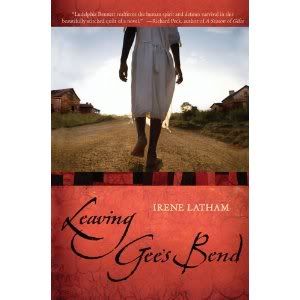It took FOREVER for me to get hold of this book! I swear sometimes my library pulls a Netflix and delays sending me books as fast as they could (I requested Shiver three months ago and have been at the top of the waiting list with the book's status listed as 'In Transit' for a month now). But I finally got Leaving Gee's Bend!
It's 1932 in Gee's Bend, Alabama, an extremely isolated and poor farming community on the banks of the Mississippi River. When 10-year-old Ludelphia's mother nearly dies after giving birth, there's no doctor in Gee's Bend to help her, just folk remedies and superstition. Ludelphia knows that in Camden, the next town 40 miles and across the river away, there's a real doctor who she is sure could save her mother. Ludelphia packs a small pack for herself, including some food and the first pieces of a quilt she's stitching by hand, and sets off on her own, determined to save her mother's life.
That bit of quilting is Ludelphia's lifeline throughout the story. As she faces physical and emotional hardships, she always grabs hold of the quilt to reassure herself that she's on the right track. Her mother has taught her that every quilt tells a story, so Ludelphia collects bits of fabric on her journey to help her tell the story to her mom and her new baby sister of the adventure. And there's lots to tell: getting swept away by the river current, meeting white people for the first time, a shop manager angry with Ludelphia's family for borrowing more money than they can repay, and a fortuitous meeting with the Red Cross all become part of Ludelphia's journey, and eventually her quilt.
As Latham explains in her author's note, Gee's Bend is a real place known for a tradition of beautiful quilt making. That bit of the story is what first drew me to Leaving Gee's Bend as my mom used to quilt all the time when I was growing up. I really enjoyed Ludelphia's struggle to put together her quilt, the first she's made by herself, and all of the different ways she thinks of to put her bits of fabric together.
As part of my commitment to combat whitewashing covers, I like to make sure I highlight well-done covers featuring people of color, and Leaving Gee's Bend qualifies:

If it's hard to see in your browser, the girl walking away from us is clearly a girl with dark skin. Penguin (the publisher) also gets points from me for putting her in a dress similar to the one that Ludephia describes herself wearing - shapeless sackcloth. She also goes through the entire book without shoes! I also really like the font used for the title.
Latham has put together quite the adventure story. Physically Ludelphia never travels that far from home, but the predominantly-white city of Camden might as well be a foreign country to her. Latham does an excellent job of bringing 1930s Alabama to life, describing the two very different cities filled with distinct characters. I highly recommend this one, not only as a great story, but as a book that fulfill's Ari's call for historical fiction about African-Americans that isn't either about Civil War-era slavery or the civil rights movement of the 60s.
3 comments:
I liked this one. I do love the font on the cover, that it's a POC and I didn't even notice, but I agree: I like that the model is wearing a "shapeless" dress.
It does answer my call, though I must admit that I was disappointed by some parts of it. I felt that the white owner was made too sympathetic. Sure she was evil, but she had a rather sad reason. Which can be realisic I suppose, but I wouldn't want any child to read this book and think that sharecropping wasn't that bad and that all white land owners were grief-deranged. I'm sure few would think this, but you never know.
I still want to know why Gee's Bend is so famous for quilting.
As always, great review!
PS I think you meant to say that you found it via Abby the librarian (that's what the link is for).
Sorry about your slow library =/
Ack, I can't believe I messed up that link. I just paid attention to the 'in my mailbox' part at the end and yours is the only IMM post that I currently read regularly. Fixed now!
On a more relevant note: you are totally right about the white store owner, though I think the hardships of sharecropping were well implied. Ludelphia couldn't complain much in the narrative about her life because until she made it to Camden she hadn't experienced life outside of Gee's Bend. But we as the readers can see that it's a hard life - lack of medicine, lack of shoes, and a few broken eggs mean no bread with dinner.
Hello, and thanks so much for reading and reviewing! Seeing the cover art for the first time was one of the most emotional moments of the whole publishing process... I looked at that little girl with her foot in the air -- actually doing this thing, leaving the only place she's ever known -- and I thought, there's my girl, there's Ludelphia. If you'd like to send me your snail mail address to irene at irenelatham dot com, I'd love to send you a little something "Gee's Bend." Happy reading!
Post a Comment